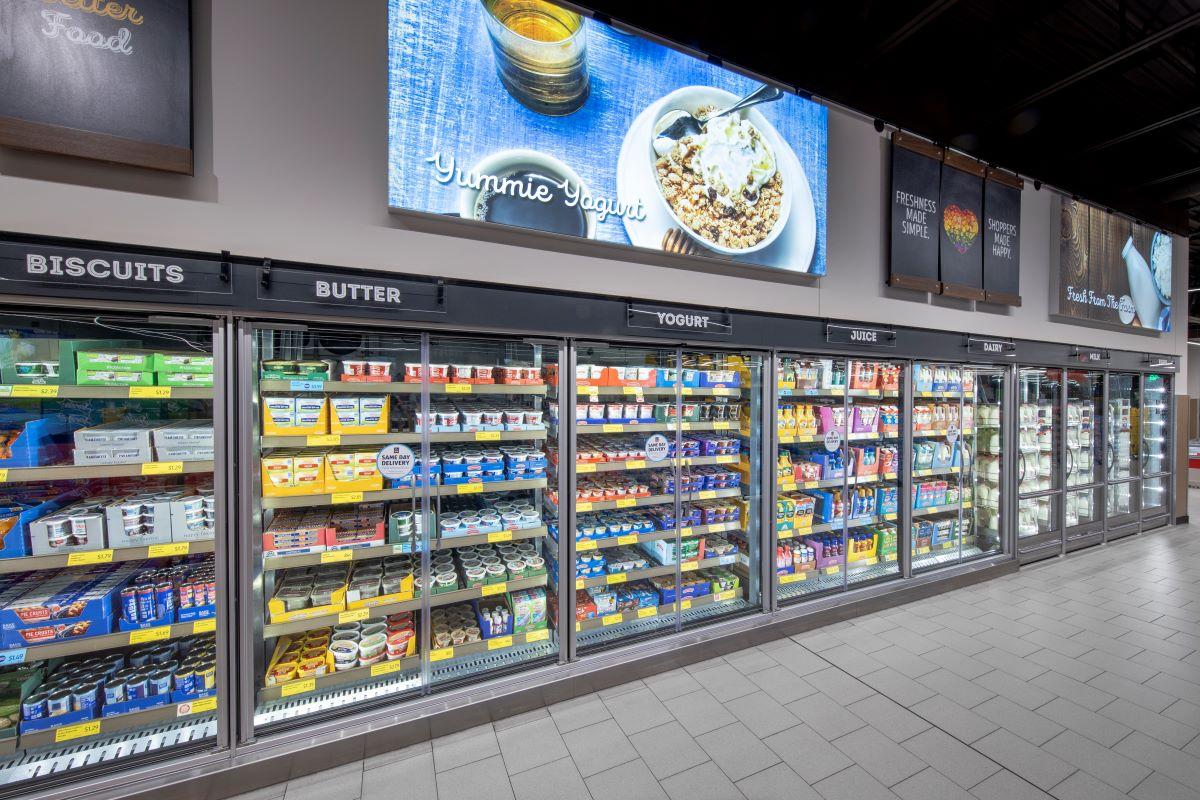ALDI Strikes a Balance Between Price and Planet
ALDI’s store footprint may be growing by leaps and bounds, but its carbon footprint is shrinking. As the German value-oriented grocer — recently named Progressive Grocer’s Retailer of the Year — is opening stores at a steady clip across the United States, it’s scaling back on elements of its business that don’t meet its sustainability standards.
The trick, of course, is to invest in new growth and pursue eco-friendlier practices while maintaining the price proposition that has given the grocer a decided halo among shoppers in recent years. The nuances of that fine-line walk aren’t lost on the company’s executives.
“We’re raising the bar on sustainability without raising prices for shoppers,” Emily Wiora, director of sustainability at Batavia, Ill.-based ALDI USA, tells Progressive Grocer in a recent interview. “We know that oftentimes, the more sustainable decision is the more efficient decision. That’s why we make thousands of small, intentional operational decisions every day that have a big impact on keeping our prices and our environmental footprint low.”
Waste Not
To Wiora’s point, incremental changes can have a big sustainability payoff without losing the passionate and often price-driven customer loyalty for which ALDI has become known.
One case in point is the removal of plastic shopping bags at the store level. It’s something that customers have not only become accustomed to, but also take some pride in as they look for ways to cut material waste in their own lives. A quick trip to any given ALDI store bears out this theory: Shoppers can be seen slinging their own bags over their shoulders or looking through the store to pick up shipping or display boxes that can be repurposed to bring home their groceries.
“ALDI shoppers have been bringing their own bags for quite some time, and they appreciate that we do things sustainably,” notes Wiora. “Before eliminating plastic shopping bags from our stores, ALDI charged for them at checkout. By never providing single-use plastic bags to our shoppers for free, we helped save an estimated 15 billion bags from landfills and oceans. Our customers have been a huge part of that success and our progress to date.”
Getting rid of plastic bags altogether elevated the cachet of being a mindful ALDI customer while aligning with the retailer’s concurrent move to keep prices affordable. “By eliminating plastic shopping bags from our stores, we are saving 4,400 tons of plastic from going into circulation each year while also reducing unnecessary costs,” adds Wiora.
In addition to entirely removing plastic bags from its front end, ALDI is tackling the thorny problem of waste in other ways. Another small but incrementally important change has been the move away from printed to electronic shelf labels, which has reduced paper waste while optimizing labor.
Heeding the issue of packaging waste, ALDI is stepping up partnerships across the supply chain. Nearly four years ago, the company became a founding activator of the U.S. Plastics Pact, working with others to move to a more circular economy. The grocer is also part of the Sustainable Packaging Coalition. “Packaging innovation is a cross-industry challenge, and we believe collaboration is key to making progress,” remarks Wiora.
[RELATED: Why a Sustainable Supply Chain Should Be a Business Imperative]
Collaboration with suppliers is central to its work to minimize packaging waste. ALDI provides guidance to its suppliers and buying teams through its International Recyclability Guidelines, and also works closely with manufacturing partners on innovation.
Wiora shares some examples. “By eliminating the clear plastic windows from our pasta boxes, we save nearly 50 tons of plastic from circulation each year,” she says. “We’ve also streamlined the design of our ALDI-exclusive vinegar bottle to use 33% less plastic, and our Fudge Marshmallow Cookie tray design to use 20% less plastic. We then look at improving packaging design to be more sustainable,” she adds, noting that more than 75% of ALDI-exclusive packaging components are now reusable, recyclable or compostable.”
As part of its commitment to a circular economy, ALDI promotes package waste reduction to its consumer base, too. “We’re working hard to make it clear to shoppers how, where and when they can recycle our packaging,” explains Wiora. “The majority of our ALDI exclusives include an easy-to-locate How2Recycle logo, which has simple instructions about how to best recycle the packaging. We know customers want to make better choices, and we’re here to make that as simple as possible for them.”
Curbing overall waste also involves addressing the significant impact of food waste, something that ALDI is working on at several operational points. “When it comes to food waste, our business model is inherently designed to create efficiency and reduce waste,” says Wiora. “Through smart ordering systems and longstanding donation programs, we are making strides to reduce food waste within our own operations by 50% by the end of 2030. Our innovative pricing and markdown tools help reduce food loss and waste, and even prevent excess buying from the onset. And when our excess food doesn’t end up feeding our customers or donation partners, we aim to use it to feed the planet. In 2022, we composted 1,645 tons of food between the ALDI Test Kitchen and select stores.”
Again keeping shoppers in that pivotal loop, ALDI encourages customers to manage their food waste at home by selling them products like reusable sandwich bags and a tumbling composter for home use.
Of course, ALDI carries nonfood products, too, and is likewise striving to keep more of those items out of landfills. Through its nonfood donation program, the grocer works with nonprofit groups to give away such products as paper goods, shoes and housewares.
Want Not
Aside from its measures to cut down on material, packaging and food waste, ALDI’s format lends itself to sustainability. The typical ALDI store, for instance, spans just 12,000 square feet. “Our smaller store layouts keep operational costs down, create efficiency, reduce waste and minimize our carbon footprint,” notes Wiora.
ALDI’s smaller assortment of 1,400 or so products is part of its price-value magic for shoppers, and also offers sustainability advantages. Fewer products, more of which are locally sourced, cut down on transportation resources and, hence, emissions and fuel use.
[Never miss a story – sign up for Progressive Grocer's FREE Daily newsletter]
The types of products it carries also help ALDI strike a balance between price and sustainability. “As our stores are stocked 90% with ALDI-exclusive brands, we are able to work closely with our suppliers to ensure they are upholding high standards and taking care of the communities we serve in and the planet while bringing our customers’ favorite products to our shelves,” observes Wiora.
Chilling Effect
ALDI is taking other measures to live up to its green goals. In January, the retailer revealed that it will transition to natural refrigerants across all of its U.S. stores by the end of 2035, including ultra-low global-warming potential (GWP) carbon dioxide and propane refrigerants.
Each store has a role to play in that initiative, as ALDI will use the best refrigerant solution for an area’s distinct climate. What’s in place in Texas, then, will be different from what will be used in the Northeast.
Here, too, cost and sustainability are in sync. As Wiora puts it: “Environmentally friendly refrigerant systems help us support a healthier planet and reduce costs, which translates to big savings for customers. It’s a win-win.”
On the cost front, carbon dioxide refrigerants have been shown to be 61% cheaper per pound than traditional refrigerants used in older stores, according to ALDI. Moreover, the high pressure that carbon dioxide operates at enables stores to use waste heat from the refrigeration system in HVAC units, also cutting expenses and outputs.
As ALDI preps for another big year of store openings and the completion of its deal to acquire Jacksonville, Fla.-based Southeastern Grocers, the company is confident in its ability to hit its metrics and its mission. “Shopping sustainably doesn’t have to be expensive,” asserts Wiora. “We make sure that our sustainability efforts — and everything we do — is good for the planet and wallets, so shoppers don’t have to choose between doing what’s right and shopping with their values.”









